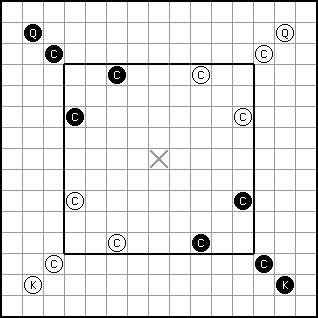| Main index | Other Papers index | About author |
Julian D. A. Wiseman
Publication history: only here. Usual disclaimer and copyright terms apply.
Queens’ Courtiers is a game intended for Lyon Court, Queens’ College, Cambridge, though it can be played on a board. The game is played on a fifteen-by-fifteen square grid, on which the central nine-by-nine square is marked. This central region is called the ‘Court’; the outer three-wide strip is called the ‘Course’. The centre square is not used in the game.
Queens’ Courtiers is for two players, each of whom has one King, one Queen, and six Courtiers, the two teams each being different colours. The initial positions are as follows:

By lot, one player is chosen to start. Players then play alternately, moving one piece in each turn. Each turn consists of either a single move or a double move.
The King may move one square in any direction, i.e., in the same way that a King in Chess may. The Courtiers move in the same fashion as Knights do in Chess. The Queen may move either one square diagonally, or exactly three squares horizontally or vertically. The Queen may not jump over other pieces, nor may she jump over the central square.
In the Course, a piece may do a double move. If a piece is doing a double move, it moves twice, as if it had two turns. There is no obligation for the second move to be in the same direction as the first; i.e., a Queen may move three to the left and then one diagonally.
A piece may not do a double move if its turn starts in the Court, nor if the first part of the turn lands in the Court, nor if the first part of the turn captures another piece. However, it is permitted for the piece to land in the Court at the end of its second move. When a double move is permitted, it is optional.
It is not permitted to move so as to cause either of one’s own Royal pieces (King or Queen) to be put into check. Hence a Royal piece may not move into check, nor may it ‘pass through check’ during a double move. This rule also prohibits a revealed check: if an enemy Queen would be checking a Royal but for an intervening Courtier of one’s own, then that Courtier may not move.
There is one exception to this rule: it is permitted to move into check if doing so wins the game.
If a Royal piece is under threat from a Courtier or a non-checked Royal, then that Royal piece is said to checked. Checked pieces are paralysed, and may not be played until the threat is removed.
Royal pieces cannot be captured, but they can capture. A Courtier that is checking a Royal piece may be captured, as may one in the Court. Courtiers may be captured by any enemy piece, Royal or Courtier. Note that Courtiers may threaten and hence paralyse Royalty in either the Course or the Court. Captured Courtiers are removed from the board, and play no further part in the game.
The object of the game is to bring one’s own King and Queen together: to move one’s King onto the same square as one’s Queen, or vice versa. This is the only time that two pieces are permitted on the same square. Also, this is the only time that a Royal piece may move into check, i.e., a Queen may move onto the same square as a checked King (or vice versa).
If a player is unable to move then that turn is forfeited. Players may not pass.
The central square is not used, and no piece may enter it or pass over it.
Game invented during the spring of 1991 by ENC, CTC, SRG and JDAW. Posted on the web February 2001.
| Main index | Top | About author |